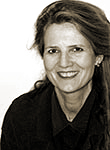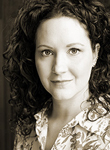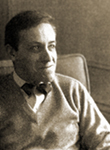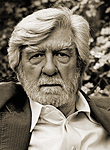Blackbird launched its first reading loop in v1n2, and since that time we have often used this feature of online connectivity to suggest approaches for reading and linking content across genres and media. Four loops appear in this issue.
The Introductions Reading Loop, an annual spring highlight, here enters its second decade of recognizing writers whose work has impressed us as unusually fine and full of promise. The six poets and three fiction writers gathered in this 2013 presentation demonstrate yet again that our best art is, thankfully, a renewable resource.
To begin the loop, poet Alice Bolin suggests “mood ring, you should be afraid / of me,” as she exposes the intimate give-and-take of our emotional relationship with the natural world. Dexter L. Booth refracts through a cloudier lens: “We aren’t that different from the cicadas / or the Century Plant; all we do is die,” he tells us. “The sounds / we push out into the universe take their time to arrive. / . . . Time slips its hands in our pockets / and laughs.”
Though Lucy, the damaged yet undefeated spirit animating three epistolary pieces by Claudia Cortese, observes that “To love is to suffer, / and to suffer is to give yourself to this world,” her dark messages cajole even as they threaten. For Joshua Gottlieb-Miller, however, perhaps the most striking presence is absence—a process, as one poem’s title suggests, of “negative theology”—“Some say [God’s] playing // hide and seek, and that he’s hiding.”
Cynthia Marie Hoffman confronts the fragility of the physical realm and its possibly threatening fault lines— “Wicked are her knuckles beating at your door,” she tells us in “No Midwives Can Do What Angels Can.” Another chronicler of the fraying edges, Corey Van Landingham gathers fragments of surreal imagery and molds them into a dream-like environment rich with ominous creatures, haunting darkness, and a speaker crippled by the “brutal condition of having hands.”
The three fiction writers, Michael Croley, Elizabeth Denton, and Thomas DeSanto, invoke the climate of the familiar by setting their sights on the often-pursued targets of parental and marital relationships.
In “Passings in the Night” and “Zeke’s Dead,” Croley and Denton masterfully negotiate the rutted road of expectation to renew our interest in and respect for known and deeply worthy people.
Although the family in DeSanto’s story inhabits a more obviously dangerous world, a struggle for decency also lies at the heart of his piece as he weaves moments of disturbing and graphic violence into a larger story of revelation and rebirth.
The second loop collects material about and/or by George Garrett, Eleanor Ross Taylor, and Peter Taylor. These remarkable writers were next-door neighbors on Wayside Place in Charlottesville, for which the loop is named. Happy circumstance has enabled us to remember them together as artists whose bodies of work and many kindnesses continue to command our attention.
Loop number three acknowledges Cabell First Novelist Award recipient Justin Torres, whose winning book, We The Animals, is a coming-of-age narrative of particular and poignant intensity and wisdom. The loop also includes a conversation with Torres, an audio capture of his reading, a panel discussion on publishing the book, and a review of the novel by Lena Moses-Schmitt.
The fourth and final loop, Jake Adam York Remembered, takes note of the passing too soon of a poet Blackbird was honored to publish and support. Forming the loop are a personal remembrance of York by Leia Darwish, an assessment of his work by Susan Settlemyre Williams, and links to work by and connected to York from our previous issues.
Other Blackbird poetry offers a plethora of images and a mighty chorus of voices as defense against a lingering chill.
Stanley Plumly’s threaded haiku grieve the last hard freeze besetting a landscape where women and men have labored and might yet come to devastation, where the predictable miracle of sunrise is made manifest only by the “roofs of barns on / fire, the dawn down snow rows of / cut December corn . . .”
Dana Levin’s subtle calculus of the quotidian—its terse equations—balances consolation and quiet rage with “just / the facts / that make waking worth doing, like / watching boiling water / buffet up an egg.”
Redemption seems elusive for Ellen Bryant Voigt’s lost boy, whose “gift / was always making something out of nothing,” or Victoria Chang’s nameless workers who suspect that “maybe the boss is / right maybe we are wrought // wrong ruined maybe the boss knows.”
Even Judy Halebsky’s Li Po broods drunkenly about the country he abandoned “because there were whole towns without work / houses worth less than the water heater / fishing hamlets without roads.” And Willie Lin poses a question for us all: “I did not rest when I rested, thought, / How long before varnish? How long before I stop dreaming only winter?”
Bare image may be one antidote to the general malaise gumming up the zeitgeist—some spiritual analogue of the shovel-ready infrastructure project? Take Dana Crum’s “flattened hummingbird outlined in its own blood” on the road to Concepción. Or Lisa Williams’s aquatic herd, grazing the fringes of Lake Chad, “at home near algae, / near succulent moss, hooves scribbling / bottom layers.” What message have they left us? On the tarmac? In the muck?
Claudia Emerson provides one possible answer by offering “daffodils blooming / like wild, / unmeant things / in what / appears an old field / without design / the kind / sumac prefers / and will / encircle—its / own transfiguring / salvage, / that—slow, / unambiguous.”
In Fiction, Lawrence Judson Reynolds has sifted the newspapers of the past for clues to what ails us in “Love and Death in Newark” and has summoned up instead only a painfully recognizable narrative of petty jealousy and rage. David Huddle, on the other hand, chronicles the illness of a beloved wife and mother to reveal the grace and beauty that can reside surprisingly close to home and manifest itself almost casually in a grief tempered by wry honesty.
In Nonfiction, Brian Henry’s lyric essays make use of the compression more common to poems to outline two seemingly minor memories that play in a major key, while Jehanne Dubrow revisits teaching Philip Larkin’s “This Be the Verse” as a beginning academic feeling her way into offering poems that matter and disturb.
Filling out the section, reviews of novels by Patrick Lawler and Casey Clabough from Michaux Dempster and Daniel Cross Turner, respectively, celebrate the flexibility and limitless potential that fiction exhibits as it creeps toward genre lines and embraces historical narrative.
Ross Losapio reviews the work of emerging poet Catherine MacDonald, recipient of the Miller Williams Arkansas Poetry Prize, while Claire Keyes and Emilia Phillips examine the most recent poetic offerings of Ann Fisher-Wirth and Lucia Perillo, which challenge and revere the notions of time and mortality.
In Gallery, playwright David Rush imagines a conversation between dancer Rudolf Nureyev and artist Jamie Wyeth that resonates with the energy created by an unusual artistic frisson.
Also, art historian and critic Howard Risatti introduces an exhibition of ceramic work that emphasizes those ties that bind the human family through the objects and rituals of the table, and information on the career and images of the work of Harvey K. Littleton accompany a video that records the beginnings of the American studio glass movement.
Selections from The Etchingham Letters, a pet-filled romp in P.G. Wodehouse territory accompanied by illustrations from the early days of cycling mined from the digital archives, round out the issue. ![]()
Return to top menus | Browse issue











